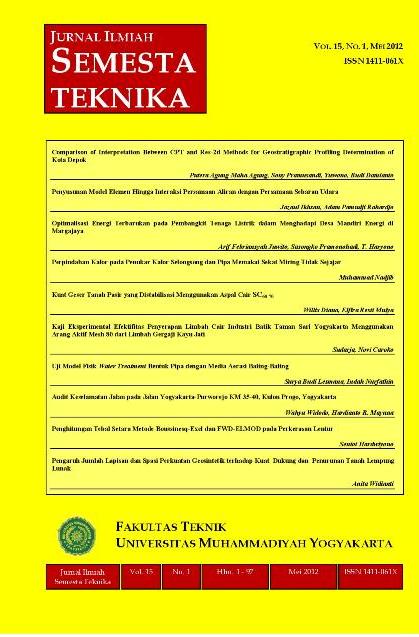Comparison of Interpretation Between CPT and Res-2d Methods for Geostratigraphic Profiling Determination of Kota Depok
DOI:
https://doi.org/10.18196/st.v15i1.438Abstract
In its simplest application, the cone penetrometer offers a quick, expedient, and economical way to profiling a subsurface soil layering at a particular site. No drilling, soil samples, or spoils are generated, therefore, cone penetration test CPT is less disruptive from an environmental standpoint. The continuous nature of CPT reading permits clear delineations of various soil strata, their depths, thicknesses, and extent, perhaps better than conventional rotary drilling operations that use a standard drive sampler at 5-ft vertical intervals. The cone penetrometer is instrumented with load cells to measure point stress and friction during a constant rate of advancement. The results can be interpreted within different theoretical frameworks or by using empirical methods, or both. RES-2D (resistivity – two dimension) completed by Geoscanner devices is applicable to interpret the soil profiling from soil exploration works. Generally, the geoscanner is used to assess the geological subsurface condition for mining works. This paper is addressed to compare the results for soil classification in Kota Depok, West Java using a cone penetration test and RES-2D. From both methods, the result of soil strata shows the soft soil in study area can be classified as clay layers from ground surface to the depth of 15.0 m. However, the CPT is less applicable to measure exactly the elevation of ground water table than RES-2D. In addition, RES-2D is also less applicable to predict the soil properties of the soil type than CPT. In general application, both devices can be applied to soil investigation for geotechnical works.
Downloads
Published
How to Cite
Issue
Section
License
Semesta Teknika is licensed under a Creative Commons Attribution 4.0 International License.
Authors who publish with this journal agree to the following terms:
- Authors retain copyright and grant the journal right of first publication with the work simultaneously licensed under a Creative Commons Attribution License that allows others to share the work with an acknowledgement of the work's authorship and initial publication in this journal.
- Authors are able to enter into separate, additional contractual arrangements for the non-exclusive distribution of the journal's published version of the work (e.g., post it to an institutional repository or publish it in a book), with an acknowledgement of its initial publication in this journal.
- Authors are permitted and encouraged to post their work online (e.g., in institutional repositories or on their website) prior to and during the submission process, as it can lead to productive exchanges, as well as earlier and greater citation of published work (See The Effect of Open Access).









